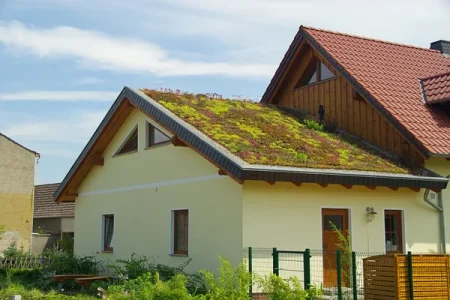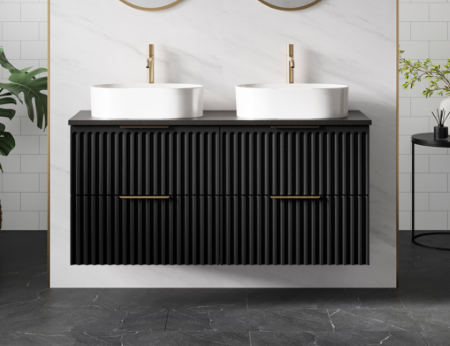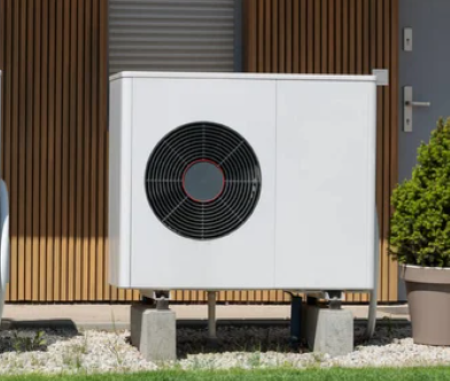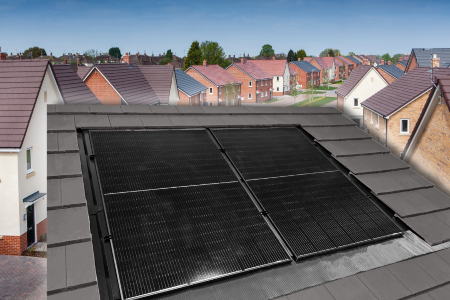In the past, new build developers may have looked more towards roofing solutions that were efficient and economical. More recently, however, sustainability has become a priority. Showhome Editor Joseph Clarke explores the different roofing materials available that cater to this newer trend
As the sound of new building developments continues to echo along our streets, from an ongoing desire to make homes even bigger and even better, house builders are faced with the dilemma of deciding which materials to use for their roofs. In the past, priority was given to more economical options for roofing. But the cheaper option is, more often than not, not the most efficient. As inflation continues to increase at rapid rates, it goes without saying that both homeowners and house builders still favour more economical options. However, concern is also being taken over the sustainability of building materials. What we now want is a tripod solution: a material that is economical, efficient and sustainable.
Sustainable roofing
In an ideal world, we would solely rely on the materials that do not cause irreversible harm to the environment. Green roofing ticks all the right boxes but remains to be seen as a much more complex technique and is therefore still not as common as other alternatives.
When we talk about sustainable roofing, we have not yet reached the point of being able to focus fully on those materials that are non-damaging to the environment and that are completely renewable. Building sustainability, instead, refers to the concept of reducing a building’s impact on the environment to a minimum. Sustainable building, and in this case sustainable roofing, means constructing roofs that do not deplete our world’s natural recourses in the process.
Within this context, the most common examples of sustainable roofing materials are slate, composite, clay, and concrete. However, let us not overlook the potential for green roofing, which is becoming more and more popular in property development, and is threatening to overtake some, if not all, of its roofing competitors.
Slate roofs
When slating a roof, knowing the origin of the slate is fundamental, and with so many different levels of quality on the market, getting to know the slate is paramount in order to establish whether the slate we have chosen will be a suitable and durable choice for the building. If we know more about the type of slate we are using, we will then be able to ascertain whether it will be easy to install and maintain.
Commonly used for roofing, cladding and paving, Welsh slate is known for its bluey tones. Welsh quarries have been providing high-quality slate for centuries, with Welsh Slate owning and operating the Penrhyn, Ffestiniog and Cwt-y-Bugail quarries in the north of Wales. This natural slate has a life expectancy of over 100 years and can withstand the most extreme weather conditions.
Natural slate is dynamic in the sense that it can be cut into any shape, although rectangular units are the most common option to be used in the UK. While natural slate tiles are still not the most economical, imported slates are a cheaper alternative for your slate roof. Purchasing from oversees can be risky, but as long as you check that the slate meets the required quality standards, this can be a smart idea.
Due to its impressive service life and excellent durability, a slate roof is a popular choice for many builders and renovators. With its timeless appeal, different varieties of slate can also make slate roofing possible without having to break the bank. However, there are many alternatives to slate on the market that are giving slate roofing a run for its money.
Composite slate
Offering the same appealing look as natural slate, composite slate or synthetic slate is much more affordable, and is both versatile and durable.
Due to their sustainable qualities and environmental benefits, composite tiles are seen by many as the way forward in the roofing industry. Synthetic composites are made up of fibreglass, asphalt and recycled paper. Thanks to expert designers, composite tiles largely resemble natural slates. In fact, it is nearly impossible to differentiate them from the more traditional ones.
Composite slate has a long lifespan, is easy to install, more economical than most alternatives and is highly sustainable. It therefore comes as no surprise to see how this roofing material is dominating new housing developments across the nation.
Clay
Clay tiles can offer durability; fire, impact and wind resistance; long life expectancy and different styles. They are also a highly favoured choice for the housing developers of today’s world, as they are both eco-friendly and energy efficient.
With their ability to withstand extreme weather conditions for hundreds of years, clay tiles are longer lasting than some roofing alternatives. As well as this, they have a Class A fire rating and can remain undamaged even through heavy hail, giving them the highest impact rating of Class 4. When installed correctly, clay tiles are also very resistant to strong winds.
There is a vast variety of styles and colour options available for clay tile roofs. These include flat tiles, barrel style, Asian style, S-shape and Mediterranean style, to mention just a few. With this in mind, clay tiles cater to a range of style preferences.
However, this roofing option does come with its downsides. Clay tiles are heavy, which can put extra strain on a building, with weights varying between 788 Ibs and 1780 Ibs per square metre. With this kind of weight sitting on top of the building, it is essential that both the framing and foundations of the build are extra strong. This might mean that budgets need to be stretched in order to prevent structural movement, which could result in minor damage to walls and ceilings, or worse still, collapsing.
In addition, clay tiles are not known for being the most economical and they are also extremely fragile. Roofers will need to handle this material with great care, to avoid breakage, and will also need to be highly skilled, as installing clay tiles requires much more technical skill – You need to have the right pattern and shapes to fit a roof and will also need to ensure that no water can get in, which means that careful and precise cutting of the tiles is essential.
Concrete
Although the idea of a concrete roof probably does not sound the most appealing, tiles made from this material can actually surpass expectations. As a cheaper and quicker material to come by, many period houses have had their roofs revamped with this alternative, maintaining the timeless beauty of the home and proving almost impossible to distinguish from the classic versions.
In addition to being less costly, concrete tiles are also very versatile; and are available in a broad range of styles, shapes and colours, thus meeting the requirements of all kinds of properties.
Regarding the sustainability factor, concrete is composed without involving environmentally damaging manufacturing procedures or materials and can also be made from recycled materials, therefore making it one of the more environmentally friendly material choices in the construction industry.
On the downside, however, concrete tiles are heavy and require stronger reinforcements in the roof. Compared to their lighter siblings, these heavy-weight tiles will be slower and more expensive to transport. Their efficiency is also somewhat disputable, as they are known to weather and lose their aesthetic appeal rather promptly. Like clay tiles, they are also prone to breaking and smashing.
Green roofs
By far the most natural roofing solution of all, and gaining five stars for sustainability, are green roofs. While this type of roof is far from the cheapest, with care and maintenance, it will live for as long as our changing climate will allow.
Green roofs have become increasingly more popular on both commercial and residential builds. Given that you are basically creating a garden on the roof, green roofing is flexible, in terms of size and shape; and will help your building to function better, reducing its impact on the environment.
The ecological benefits to green roofs are numerous. Not only do they absorb heat from the sun, they also absorb CO2 and a large proportion of the water that falls on them. Providing natural insulation, this type of roofed building will enjoy warmer temperatures in the winter and cooler ones in the summer. Lastly, applying a green roof to a building means that you are replacing the land that was taken away for the house to be built upon.
Although this type of roofing is not the cheapest, developers need not feel they must use this alternative to cover the entire space. Green roofs can be combined with other, more economical options, such as composite slate, to create a visually stunning, natural look, that is efficient and sustainable.
Green roofing is not a simple technique, but with the right knowledge on how to install it, the correct type to use, drainage systems, which plants to use, and how to look after it, this alternative can really help you to raise the roof.
Green roofing systems
Intensive (thick), extensive (thin) and semi-extensive are the three main kinds of green roofing.
Intensive systems are comprised of a thick layer of soil in which a large variety of grasses, herbs, flowers and shrubs can grow. In order to maintain them, these gardens need to be accessible, but on the upside, this means that they can also be used for recreational purposes.
Providing a natural habitat for wildlife, good insulation for the house and effective water absorption, intensive systems are a beautiful addition to any new build. They do, however, require a great deal of love and care.
Perhaps more appealing to housing developers are extensive systems, as their shallow layer of soil, with low-growing grasses and mosses, needs less maintenance. That said, their level of insulation quality is fairly low, and they will therefore need to be placed on top of a conventional insulation system.
Although they are slightly deeper than extensive systems, semi-extensive systems also allow for a large diversity of plants and are easy to maintain.
Installation
For a green roof to thrive, it must be installed on a surface with an angle no greater than 30°. The planting is the icing on the cake, while knowing what to place underneath is the more important matter to be considered with care.
To keep the water in the soil, a moisture-retention blanket should be used, preventing liquid from gathering in puddles or pools on the membrane surface. Excess water should be expected but is easily carried away by aqua drains. When choosing a membrane, there are many cheap materials on the market that will prevent leakage. A vapour control layer should also be installed to enable the passage of internal water vapour through the roof and prevent condensation.
Drainage
The first step to creating a green roof is to protect the building from dampness and water damage. This can be achieved through installing, first and foremost, a protection layer. This should come in the form of a puncture-proof geotextile.
As soil is renowned for absorbing rainwater, an adequate drainage system then needs to be incorporated into the garden roof, to ensure that this water is able to run away without causing any damage to the building below. Gravel is a more traditional approach but is heavy on the roof. Lighter alternatives are available, however, in the forms of plastic drainage layers or even seashells.
Filter sheets must also be used to prevent the soils from washing out. Not only should these sheets be placed under the soil, but also up the sides of all perimeters.
Finally, guttering should be installed to enable the excess water to run away from the roof and into the ground. Conventional guttering can be used to take on this task.
Plants
The best plants to use on any green roof are those which are planted and seeded, as these encourage the garden to grow and adapt to its environmental conditions. A wide variety of sedums and wildflowers is recommended; including alpines and bulbs, bulbous plants like chives, mountain plants like Muscari, autumn bulbs like meadow saffron, native wildflowers and native herbs. Not only are the latter resilient to extremer conditions, but they will also give off a lovely faint perfume.
Come rain or shine, there is an endless supply of plants and flowers that will thrive on a green roof.
Sustainable and efficient, with the option of a more economical semi-extensive system, green roofs provide year-round beauty for the eye and a treat for the nostrils; and just generally lift the building to new heights.
Read more news and exclusive features in our latest issue here.
Never miss a story… Follow us on:
Showhome
@Your_Show_Home
@Showhomemag
Media Contact
Joseph Clarke
Editor, Showhome
Tel: +44 (0) 1622 823 920
Email: editor@yourshow-home.com






